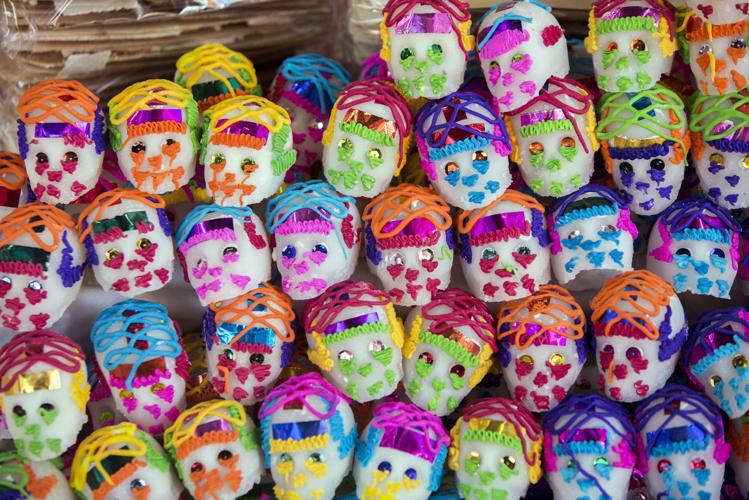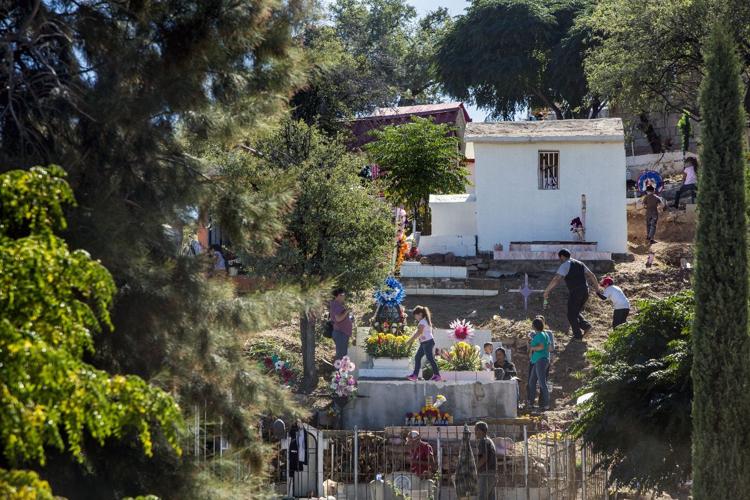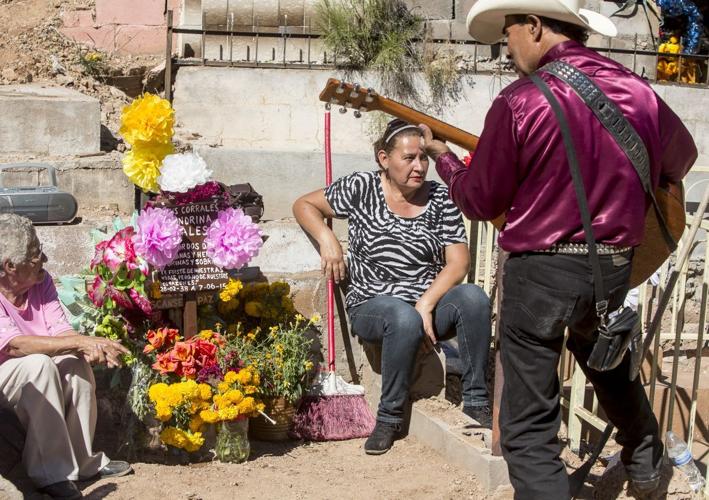NOGALES, Sonora — The city’s cemetery is dotted with blues, reds, pinks and yellows — lots of yellows.
On Nov. 1 and 2, thousands of families descend from throughout the city and across the border to visit their departed loved ones.
People start trickling in early in the morning and stay through the late night. They clean the gravesites and adorn them with fresh flowers, sold for a couple of dollars a bunch by vendors who set up shop along the streets.
When they’re finished, they light a candle before heading back home.
Beatriz Uriol, 59, bought more than 40 pounds of bright marigolds, pink cockscomb bunches and daisies to decorate the graves of her brother, who died 47 years ago, and a grandson who died 14 years ago when he was just four days old.
By midday the ever-growing cemetery, with graves being dug further up the hill, is full of families. The smell of fresh flowers, street tacos and roasted corn fill the air. Echoing over the gravestones are the sounds of children playing, of songs dedicated to the departed, of rakes against the rocky soil as people remove debris.
The festivity is a multi-generational family gathering, where children who are off from school accompany their parents, grandparents and even great-grandparents. Some seem to fully understand what they are doing there, but for most it’s a fun day where they get to play in the cemetery with their toy trucks, run around and eat candy.
Vendors yell out, their rhythmic cries selling peanuts, candied apples, cotton candy and flowers for five pesos, less than 50 cents.
“Day of the Dead is to celebrate those who we’ve lost,” said Uriol, “and we come here as a way to say thank you. Thank you for being our brother, for being our son.”
She arrived with her granddaughters early on Nov. 2 with plans to stay until the sun set. “We eat breakfast, lunch and dinner here,” she said.
El Día de los Muertos has been celebrated in Latin America for more than 3,000 years. For most, it is not a day to mourn, but to celebrate.
Nov. 1 is All Saints Day and Nov. 2 is All Souls Day. During this time some believe the souls of the departed come back to visit.
To welcome those spirits, some make altars decorated with photos of the person who has died along with his or her favorite food and drink.
The Gutierrez family, Nogales natives, not only create a traditional altar in their home, but also bring pictures to the cemetery and decorate the gravesite with a “Day of the Dead” cloth and a cross of marigolds.
For them it’s a time to get together and remember their brother, one of six siblings, who died in a car crash five years ago.
They bring coolers with snacks and drinks and spend the day by his grave, telling stories of the foods he liked — cake and ceviche — and what a happy person he was. After the sun goes down they light the candles, turn on music and dance.
In Nogales, people have been coming to the cemetery to clean and spend time with their loved ones for many decades. About 40 years ago the celebration expanded to the street with more and more vendors. Today, a line of booths snakes along the walls of the cemetery.
The tiny, temporary shops sell everything from knockoff shoes and bags to Day of the Dead bread and sugar skulls.
Outside the cemetery the atmosphere feels like a carnival, complete with jumping castles and games. Music blares from speakers.
While some appreciate the lightness of the event, others feel it takes away from paying their respects — especially those for whom the loss is more recent.
Trinidad Delgado poured buckets of water over her son’s freshly painted blue grave, while her daughter made him a wreath. He died two years and three months ago. For her, this day signifies sadness, she said, as tears filled her eyes.
Another man, Rodolfo Armenta, quietly repainted his late mother and baby brother’s headstones inside an enclosed gravesite. They were killed by a drunk driver in 1993. He also visited his brother’s grave. He was killed two years ago.
Ruben Jorqueras Burrola, 34, found a quiet moment to reflect.
Sitting next to his grandfather’s white cross and smoking a cigarette, he remembered everything Francisco Burrola Valenzuela taught him.
Don Pancho, as he was called, was a strict but humble man who always lent a hand, his grandson said.
“He raised me as his son,” Burrola said, tears rolling down his cheeks.
While touching the white cross, he said, he felt a calmness come over him.
“It’s as if he was with me,” Burrola said, “telling me to work hard, to not give up.”









